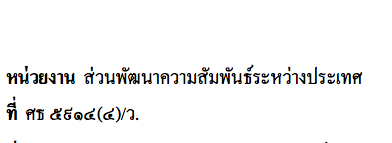| Strana na temi: < [1 2] | ก. ข. ค. ง. จ. ฯลฯ used with document numbers Objavljivač niti: Dylan J Hartmann
|
|---|
Theresa Somsri 
Tajland
Local time: 21:44
Član (2016)
tajlandski na engleski
| Simple transcription | May 6, 2018 |
Document numbers are used only to provide references, with no impact on the meaning of the translated document. Thus, it would make the most sense to transcribe the characters, as the reader will be able to look at the document and recognize the string of characters as a reference number instead of a transcribed word or name.
Investopedia states that:
Reference numbers make it easier to concisely fit the transactions on a sheet of paper, as it requires only the use of a st... See more Document numbers are used only to provide references, with no impact on the meaning of the translated document. Thus, it would make the most sense to transcribe the characters, as the reader will be able to look at the document and recognize the string of characters as a reference number instead of a transcribed word or name.
Investopedia states that:
Reference numbers make it easier to concisely fit the transactions on a sheet of paper, as it requires only the use of a string of alphanumeric characters to describe a transaction rather than spelling out the transaction’s full details.
(https://www.investopedia.com/terms/r/reference-number.asp#ixzz5EiUbClNa)
The main keywords from this statement should be "easy", "concise" and "use of a string of alphanumeric characters to describe a transaction" - we can substitute transaction with document as the meaning is still applicable.
Also, document numbers and reference numbers are not always based on an abbreviation, but sometimes on the organization's system of reference. Some systems assign their own meaning to a letter or series of letters, treating individual letters as variables to indicate specific values instead of abbreviations (similar to that of license plates, as in http://www.samuitimes.com/thai-number-plates-explained/).
If the situation was reversed:
Document No. PMF.2018-05
เอกสารเลขที่ พมฟ.๒๐๑๘-๐๕
would make a lot more sense (and be much more readable) than
เอกสารเลขที่ พีเอ็มเอฟ.๒๐๒๘-๐๕
It is also highly unlikely that our documents are translated into English for a person with a Thai background who cannot read Thai or for internal processing within a Thai institution or organization. Adding "or" to the end of a letter (e.g. SorThor) is both unneeded and confusing, especially to a client who is not located in Thailand and/or not familiar with the Thai language. ▲ Collapse
| | | |
Theresa Somsri wrote:
Document numbers are used only to provide references, with no impact on the meaning of the translated document. Thus, it would make the most sense to transcribe the characters, as the reader will be able to look at the document and recognize the string of characters as a reference number instead of a transcribed word or name.
I totally agree with Somsri.
This topic is concerned most in administrative, legal as well as technical Thai documents.
For extensive discussions on translation arts, this topic is quite a challenge. Nowadays many non-Thai translators do translate and localize Thai public documents globally. For purpose of traceability which is strongly demanded in ISO quality assurance processes, respective translators can design an effective and acceptable style. In contrast, Thai public agencies e.g. legal courts want strict transcriptions of those documents.
Soonthon L.
| | | | | Advantages and disadvantages | May 8, 2018 |
In my experience the reverse system is used in Thai translations of certain English abbreviations/codes in clinical trial documents. For example, "REGN2810 (Anti-PD-1 Antibody)" is translated as "อาร์อีจีเอ็น2810 (แอนติบอดีต่อต้านพีดี-1)". I recognise that these aren't document numbers, however they illustrate the point of this method - to stay as faithful to the official version as possible.
I certainly s... See more In my experience the reverse system is used in Thai translations of certain English abbreviations/codes in clinical trial documents. For example, "REGN2810 (Anti-PD-1 Antibody)" is translated as "อาร์อีจีเอ็น2810 (แอนติบอดีต่อต้านพีดี-1)". I recognise that these aren't document numbers, however they illustrate the point of this method - to stay as faithful to the official version as possible.
I certainly see the advantage of using straight roman alphabet letters in many of the document number/code examples described above, where readability may be more important than fidelity to the source. My point in previous posts, however, was that there is also a disadvantage to using this method that we should be aware of, that this could be the reason the SorThor method was preferred in the first place, and that if we use the letter-only method for all untranslatable Thai codes/abbreviations (as 'consistency is key') there are cases where it may be inappropriate.
Regarding implementation of these approaches, though, it doesn't seem so complicated. If your client dislikes or is unduly confused by your method, by all means use the system they prefer, no? ▲ Collapse
| | | | | Interesting omission | May 20, 2018 |
Dylan Jan Hartmann wrote:
For university documents, looking at documents from my former workplace, the ศธ had been taken out completely:


I'm surprised that the formal document omits ศธ. all together. I guess that avoids the issue but it is not very helpful. I agree that ST. would make no functional sense, neither is 'Sor Thor' (or 'Sor Tor' - now you're having another phonetic pronunciation issue). As a matter of preference I would find out what ศธ. stands for which is ศึกษาธิการ and I would translate it to Department of Education. And I will stop there. Anyone out there would translate it as DE. ?
| | |
|
|
|
Dylan J Hartmann 
Australija
Član (2014)
tajlandski na engleski
+ ...
Moderator ovog foruma POKRETAČ TEME | DE, are you sure? | Aug 2, 2018 |
Pleayo Tovaranonte wrote:
As a matter of preference I would find out what ศธ. stands for which is ศึกษาธิการ and I would translate it to Department of Education. And I will stop there. Anyone out there would translate it as DE. ?
This, I suppose, highlights many of the issues with translating Thai-English. There are so many varied opinions and preferences - consistency is so varied!
@Pleayo There is no such thing as the Department of Education in Thailand. If anyone was using DE., as you suggest, they might not be understood.
A simple search shows ศึกษาธิการ = Ministry of Education. I have seen some use MOE but as we are referring to document numbers rather than abbreviations, I wonder if this would be the right choice. It is an improvement from SorTor though.
| | | | | Public official styles | Jun 25, 2024 |
Dylan J Hartmann wrote:
We often see the Thai letters used along with document numbers when translating.
When the Thai letters are an abbreviation for a place name, and the abbreviation of that place name in English is well-known, I assert that the English abbreviation is to be used. Eg. อย. - FDA and not OrYor.
We often see these characters transcribed phonetically using RTGS or another form of transcription but writing in this phoneticised manner seems inappropriate for audiences outside of Thailand, as it leads to more questions and confusion rather than understanding, or claims that terms have been left untranslated. For example, if a Thai translator transcribes ศธ as SorThor, the client might ask, "Why have you left the word SorThor untranslated at the top of the page?"
There are various examples with other Thai agencies using the single letter transcriptions but the phoneticisation approach seems all too common. I'd like to open the forum up for discussion on this.
Secondly, if the Thai letter จ is transcribed, for example, how does one differentiate between ช if you insist on using the RTGS method? ก ข ค all have the same problem.
I understand there is already much disagreement and criticism of the RTGS and ISO transcription methods, possibly leading to much of the inconsistencies in Thai transcription. So what should we as translators use?
Looking forward to hearing everyone's thoughts on this matter.
Dylan J. Hartmann's comments address significant issues in the translation of Thai abbreviations and phonetic transcriptions. Here's an analysis of his statements:
### Key Points Raised by Hartmann:
1. Use of Well-Known English Abbreviations:
Hartmann argues that when Thai letters are abbreviations for place names or organizations with well-known English equivalents, the English abbreviation should be used. For instance, อย. (the Thai FDA) should be translated as FDA rather than phonetically transcribed as "OrYor." This approach helps avoid confusion and enhances understanding for non-Thai audiences.
2. Phonetic Transcription Issues:
He notes that phonetic transcription, such as using the Royal Thai General System (RTGS) or other methods, can lead to confusion. For example, transcribing ศธ as "SorThor" might prompt questions from clients about why it appears untranslated. This issue is compounded by the fact that many Thai agencies use single-letter transcriptions, making the phonetic approach less practical and more confusing.
3. Differentiation Challenges in RTGS:
Hartmann points out that certain Thai letters (e.g., จ and ช) have similar phonetic transcriptions in RTGS, which can create ambiguities. This problem is also evident with letters like ก, ข, and ค, which can be indistinguishably transcribed.
4. Disagreements and Inconsistencies in Transcription Methods:
He acknowledges existing disagreements and criticisms regarding RTGS and ISO transcription methods. These inconsistencies complicate the standardization of Thai transcription in translations.
### Suggested Approach:
Hartmann advocates for a more practical approach in translation that prioritizes clarity and understanding for the target audience. Specifically, he suggests:
- Using Established English Abbreviations: For well-known organizations and terms, using the established English abbreviations ensures that the meaning is immediately clear to the audience.
- Avoiding Phonetic Transcription for Abbreviations: Instead of phonetically transcribing Thai abbreviations, translators should use the appropriate English term to prevent confusion.
### Discussion Points:
1. Audience Consideration:
The target audience's familiarity with Thai terms and abbreviations should guide the translation approach. For international audiences, using well-known English abbreviations can prevent misunderstandings.
2. Consistency in Translation:
Establishing consistent translation practices for abbreviations and terms can enhance clarity and reliability in translations. This might involve creating standardized guidelines for when to use phonetic transcription and when to use direct translations or established abbreviations.
3. Challenges in Implementation:
Implementing these suggestions might require translators to have a deeper understanding of both Thai and English terminologies and their contexts. Additionally, there may be cases where no well-known English equivalent exists, necessitating a careful decision on how to best represent the term.
### Conclusion:
Hartmann's observations highlight a critical aspect of translation work that involves balancing fidelity to the source language with clarity and comprehension for the target audience. By advocating for the use of well-known English abbreviations and reducing reliance on phonetic transcription, he aims to improve the effectiveness and readability of translated documents. This discussion invites further input from the translation community to refine and standardize these practices.
| | | | | Strana na temi: < [1 2] | To report site rules violations or get help, contact a site moderator: You can also contact site staff by submitting a support request » ก. ข. ค. ง. จ. ฯลฯ used with document numbers No recent translation news about Tajland. |
| Wordfast Pro | Translation Memory Software for Any Platform
Exclusive discount for ProZ.com users!
Save over 13% when purchasing Wordfast Pro through ProZ.com. Wordfast is the world's #1 provider of platform-independent Translation Memory software. Consistently ranked the most user-friendly and highest value
Buy now! » |
| | Trados Studio 2022 Freelance | The leading translation software used by over 270,000 translators.
Designed with your feedback in mind, Trados Studio 2022 delivers an unrivalled, powerful desktop
and cloud solution, empowering you to work in the most efficient and cost-effective way.
More info » |
|
| | | | X Sign in to your ProZ.com account... | | | | | |










